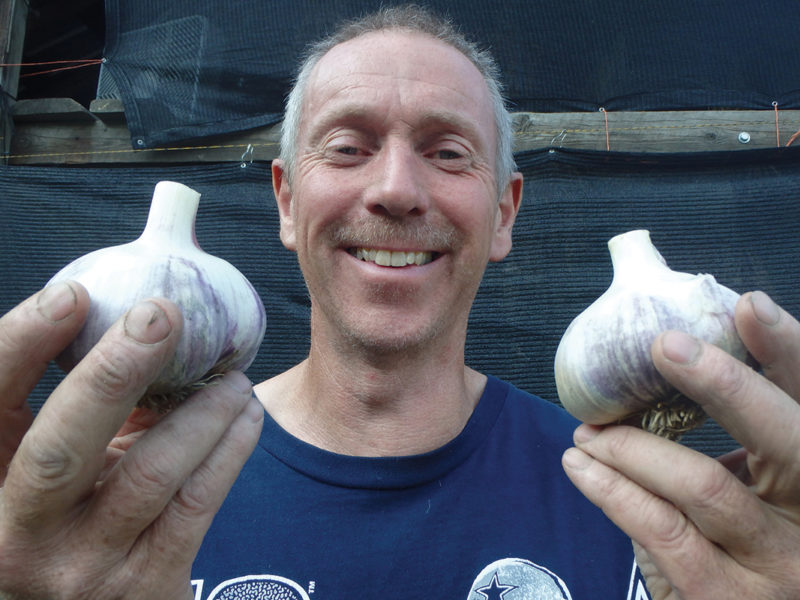KELOWNA – BC garlic growers are harvesting about four times as much garlic as they did a decade ago, but a cool spring and wet weather just before harvest challenged some growers this year.
“It was a very stressful year for many of my growers,” says Jim Capellini of Rasa Creek Farm in Lumby. He’s grown garlic since 2009. He markets seed garlic purchased from about a dozen other growers who sell directly to him.
Capellini planted about 4,000 cloves last fall for harvest this summer.
“I lost about 30% of my crop because it was too wet. Bulbs began to develop mold while still in the ground prior to harvest,” he explains.
Two of the organic growers who supply him with seed fared even worse than he did, losing their crops to botrytis.
“Both farms were certified organic, and so my access to certified bulb was seriously restricted,” he says.
Botrytis spores can travel with seed stock to new fields, introducing the fungus to an otherwise clean crop when conditions are right. Organic growers have few options for controlling the fungus, so neither Capellini nor his growers felt comfortable reserving a portion of this year’s crop for seed sales.
Ian Richardson, who’s been growing garlic since 1988 and has operated Rocky Ridge Farm in Mara since 2000, planted about 20,000 cloves on half an acre this year. While he didn’t see significant losses, the weather made it tough to cure the crop.
“Our growing season was okay, just okay,” he says. “We lost some garlic as it was too wet, especially right before harvest time, which is when you want garlic to be drying out in the ground. In a normal year, you quit watering about two weeks before you harvest. This year it rained almost right up to harvest.”
Abdul Majid of BC Garlic Growers Inc. in Abbotsford also faced challenges curing his crop. He farms 48 varieties, for a total of approximately 150,000 plants. The quality was excellent, but didn’t come without effort.
“We had a fantastic crop,” he says. “The least amount of crop loss, and crop quality was great and sizes were amazing. … But rain once a week wasn’t good for drying and curing these large heads.”
Doug Saba of Curly Willow Organic Farms in Grindrod lost about a quarter of his crop, or more than 900 bulbs, to botrytis. His Russian Red was more affected than his Yugoslavian garlic.
Fortunately, he was able to salvage enough good cloves to replant this fall, hoping that the healthy cloves will give next year’s crop a measure of resistance to the fungus.
To try and ward off fungus issues with his next crop, Saba will use less mulch around his plants. He may also look for an organic product to treat them in the spring. Knowing that this years crop had botrytis, he chose not to sell it as seed garlic.
Kelowna grower fared well
Even with a cooler spring, some growers in Kelowna saw good crops.
Now in their third year of garlic production, Michael and Jane Johnston of Avoca Farms and Vineyards had their best crop ever.
They used garlic as a way to boost cash flow while developing their aronia berry operation. They seeded 165,000 cloves in the ground on about 2.5 acres, and another 30,000 in pots.
Jane says 75% of the cloves produced heads of garlic varying in size. They were happy with the outcome, attributing their success to their sandy soil and greater experience.
A notable challenge this year was voles. While garlic is supposed to deter the rodents, the vole population seemed higher this year. The tiny varmints not only made runs through the field but moved bulbs, increasing the risk of disease spreading around the planting.
She says their potted garlic turned out even better due to the controlled growing environment. Michael’s familiarity with potted growing in Ireland, where the method is more common, prompted them to give it a try in Canada.
“It took a year of trial and error to get the fertilizer, watering and management of it in place,” she says, “but, overall, we were very successful for what many have told us was a challenging year.”
Monde Janzen of Janzen Garlic Acres Inc. in Kelowna was pleased with the results of her own 5,000 plants following a poor crop in 2019.
Janzen relocated from her operation from Abbotsford to Kelowna two years ago. Although she had success with the crop in Abbotsford, she’s spent the last two years adjusting to local growing conditions in the Okanagan.
“We got good quantities but I learned that we’ll stick with hard-neck garlic and work next year to increase the garlic’s size,” she explains.
Janzen sees opportunities for local garlic and plans to plant 30,000 to 35,000 cloves this fall, using a garlic splitter to separate them from the heads. The splitter reduces labour costs.
The ambition and innovation of growers like Janzen and the Johnstons give Capellini confidence in the future of the sector. He’s been working to grow it since planting his first 107 cloves of Russian Red, German Red and Yugoslavian garlic in 2009. He expanded to 40,000 bulbs annually and planned to grow even larger, but scaled back to focus on growing the industry through workshops and seed sales.
Capellini believes there’s a hole in the marketplace that could be filled with locally produced garlic.
According to international trade data, Canada imported 45.6 million pounds of garlic worth $60.5 million last year. China accounted for more than 80% of imports, followed by the US and Spain.
“We’re still importing 85% of what we need for fresh garlic in Canada,” says Capellini. “The demand is there, if people can produce it.”


 New barn promises better egg production
New barn promises better egg production